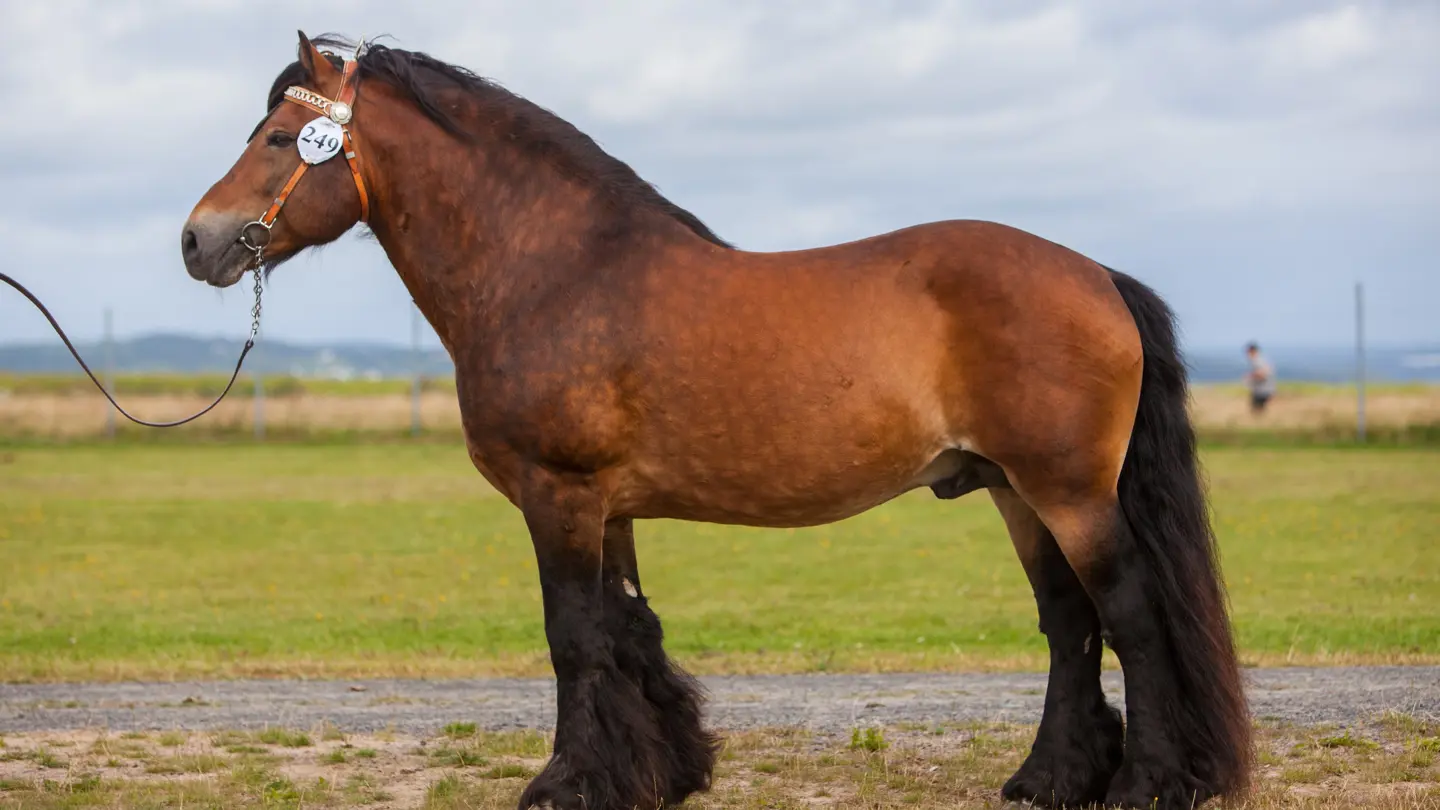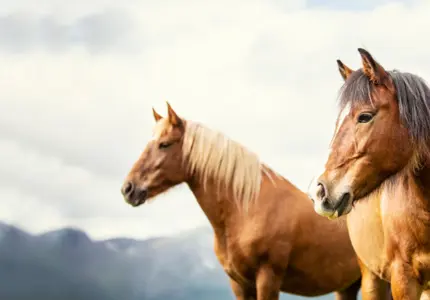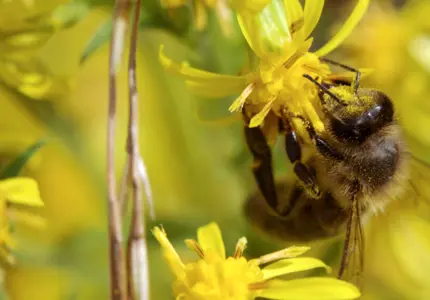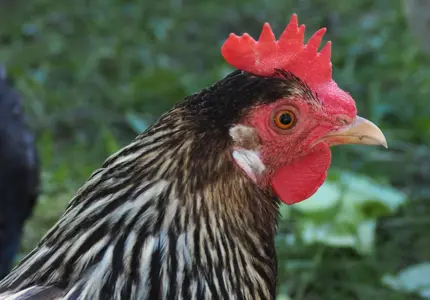
North Swedish horse
- Home
- Our work
- Farm animals
- Nordic native breeds
- North Swedish horse
Origin: Sweden
Native name: Nordsvensk brukshäst
Weight: 500-750kg
Withers height: 153cm (mare), 155cm (stallion)
Appearance: brown, black, tan, chestnut, dun, dilute colouring, grey. Commonly with paler muzzle and abdomen.
Type: Medium sized, coldblooded horse, working horse.
Birthweight: appr. 50kg
Number of breeding mares in Sweden (2022): appr. 4500
Number of covered mares annually (2020): appr. 452
Number of registered foals in 2020: 241
Not at Risk – Vulnerable – Endangered – Critically – Endangered Extinct
Publication date: 10 September 2024
Background
The North Swedish horse derives from local horses in the Swedish mainland, and is described as a dependable, calm and durable breed. The breed was established in the 20th century, while its breeding association was founded in 1924. The breed’s ancestor had had a long history as a human companion: The horse has been illustrated both as a riding horse and draft horse in the petroglyphs from the Bronze Age. After the invention of the harness in the 8th century, the horse was used to pull heavier loads, and as the trade between Norway and Sweden increased, it was this breed that was largely used to transport goods both within Sweden and across the border to Norway.,
The industrialization in the 19th century increased focus on productivity which led to the utilization of larger machines and therefore required heavier working animals. Subsequently, different European breeds were imported for crossbreeding, where the Ardenner horse in the south of Sweden became most suitable for this kind of heavy work. In the northern regions of Sweden however, the North Swedish horse became an asset, because its characteristics were more valuable in smaller agricultural sites and for forestry. In 1900 the breed was founded under the breed name North Swedish horse, and in 1924 its breeding association was founded. In the middle of the 20th century, the North Swedish horse was divided into two breeds: the North Swedish working horse (stronger and heavier) and the cold-blooded trotter (lighter and faster).

Conservation efforts
Preservation of traditional landrace breeds already began in the 1970s. For instance, it was decided that the direct responsibility for genetic conservation would lie with each country. In Sweden, this responsibility was appointed to the Swedish Board of Agriculture. Further, it was also decided that Nordic cooperation in the area would be carried out by a professional group under the Nordic Council of Ministers.
In 1978, the government in Sweden made an inquiry into domestic animal breeds and methods for preservation and utilization of their genetic resources. In addition, it was also decided that finance should be provided to the Nordic Gene bank for Farm Animals, although the actual efforts did not begin until 1984. The main focus for Sweden used to be on preserving threatened national endangered breeds, but this has changed to include national breeds that are used commercially.
Presently, the Swedish Board of Agriculture has the overall responsibility for the preservation of the breed. The responsibility for practical breeding work belongs to the breeding association for the North Swedish horse (https://nordsvensken.org/). Here, the main goal is to ensure a viable population by limiting inbreeding and increasing the population size, while the long-term goal for the breed is to maintain a minimum of 750 mares in breeding annually.
Characterization of the breed in science
Characterization is an important part of conservation efforts concerning breeds such as the North-Swedish horse, because it provides insight into characteristics unique to the breeds that can be used in the future. For instance, traits such as endurance, robustness and the calm nature of the North Swedish horse are important features in a companion animal, especially with the increasing variability of our climate.
Based on a systematic study carried out by NordGen (Kierkegaard et al. 2020), 11 accessible studies including the North-Swedish horse had been carried out until 2019. Nine of these focused on molecular genetic diversity within and between breeds and other selected breeds. The two remaining studies characterized genetic diversity based on pedigree information. Continuing to investigate and categorize new traits in the breed remains crucial to improve our knowledge of the breed, which will, in turn, allow us to establish better strategies for its future conservation.
The North Swedish horse is an important part of Sweden’s cultural heritage which is why it remains important to develop historical knowledge about both breed development and its significance for humans, as this will shed light on our own societal development.
References
Gustafsson, S., Nord, M. (2010). Bevara, nyttja och utveckla – handlingsplan för uthållig förvaltning av svenska husdjursraser 2010-2020. Stålhammar, E.-M., Frid, G. (Eds.) (2016). Jordbruksverket och Centrum för Biologisk Mångfald, Sverige.
Jordbruksverket (n.d.). Lantraser i genbank. Jordbruksverket, Jönköping, Sverige.
Föreningen Nordsvenska hasten (n.d.). Avelsprogram och reglementen för Nordsvensk Brukshäst.
Kierkegaard, L.S., Groeneveld, L.F., Kettunen, A., Berg, P. (2020). The status and need for characterization of Nordic animal genetic resources, Acta Agriculturae Scandinavica, Section A — Animal Science, 69:1-2, 2-24, DOI: 10.1080/09064702.2020.1722216.
Bohlin, O. & Rönningen, K. (1975). Inbreeding and relationship within the North-Swedish horse. Acta Agriculturae Scandinavica 25(2), 121–125. doi:10.1080/00015127509436242.
Klemetsdal, G. (1999). Stochastic simulation of sire selection strategies in North-Swedish and Norwegian cold-blooded trotters. Livestock Production Science 57(3), 219–229.
Lindgren, G., Backström, N., Swinburne, J., Hellborg, L., Einarsson, A., Sandberg, K., Cothran, G., Vilà, C., Binns, M. & Ellegren, H. (2004). Limited number of patrilines in horse domestication. Nature Genetics 36(4), 335–336.
Promerová, M., Andersson, L. S., Juras, R., Penedo, M. C. T., Reissmann, M., Tozaki, T., Bellone, R., et al. (2014). Worldwide frequency distribution of the “gait keeper” mutation in the DMRT3 gene. Animal Genetics 45(2), 274–282. doi:10.1111/age.12120.
Petersen, J. L., Mickelson, J. R., Cothran, E. G., Andersson, L. S., Axelsson, J., Bailey, E., Bannasch, D., et al. (2013a). Genetic diversity in the modern horse illustrated from genome-wide SNP data. Edited by Hans Ellegren. PLoS ONE 8(1), e54997. doi:10.1371/journal.pone.0054997.
Petersen, J. L., Mickelson, J. R., Rendahl, A. K., Valberg, S. J., Andersson, L. S., Axelsson, J., Bailey, E., et al. (2013b). Genome-Wide analysis reveals selection for important traits in domestic horse breeds. Edited by Joshua M. Akey. PLoS Genetics 9(1), e1003211. doi:10.1371/journal.pgen.1003211.
Viluma, A. (2012). Polymorphism in myostatin gene and athletic performance in Nordic horse breeds. Swedish University of Agricultural Sciences, available at: http://stud.epsilon.slu.se/id/file/2988345
Fegraeus, K. J., Velie, B., Axelsson, J. & Lindgren, G. (2018a). Selective sweep mapping using a unique Nordic horse model revealed edn3 as a candidate gene for harness racing performance. n.d. PAG - Plant and Animal Genome XXVI Conference, January 13–17. Accessed 24 September 2019, available at: https://pag.confex.com/pag/xxvi/meetingapp.cgi/Paper/28321
Fegraeus, K. J., Velie, B. D., Axelsson, J., Ang, R., Hamilton, N. A., Andersson, L., Meadows, J. R. S. & Lindgren, G. (2018b). A potential regulatory region near the EDN3 gene may control both harness racing performance and coat color variation in horses. Physiological Reports 6(10), e13700. doi:10.14814/phy2.13700.
Velie, B. D., Lillie, M., Fegraeus, K. J., Rosengren, M. K., Solé, M., Wiklund, M., Ihler, C.-F., Strand, E. & Lindgren, G. (2019). Exploring the genetics of Trotting racing ability in horses using a unique Nordic horse model. BMC Genomics 20(1), 104. doi:10.1186/s12864-019-5484-9.
Staiger, E. A., Almén, M. S., Promerová, M., Brooks, S., Cothran, E. G., Imsland, F., Fegraeus, K. J., et al. (2017). The evolutionary history of the DMRT3 “gait keeper” haplotype. Animal Genetics 48(5), 551–559. doi:10.1111/age.12580.
Read more about our other native breeds
-

Nordland/Lyngen Horse
The first known and documented exhibition where this breed participated, was in 1898 at Lyngseidet in Troms. In the 1930s, organized breeding of Nordland/Lyngen horses started.
Read more about the breed
-

The Nordic brown bee
Honey bees are threatened by intensive agriculture, habitat loss and climate changes worldwide and are important to conserve, not only due to their honey production but also due to their pollination services.
Read more about the breed
-

Finnish Landrace Chicken
In 1974, the agricultural advisory agency collaborated with Seiskari and published a call to find remains of the Finnish landrace chicken. As a result, one flock was found in South-East Finland. This family line was named after its geographical location as “Savitaipaleenkanta”.
Read more about the breed